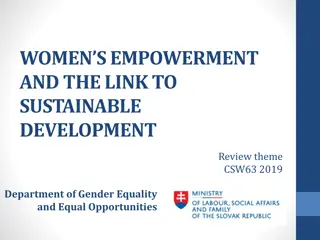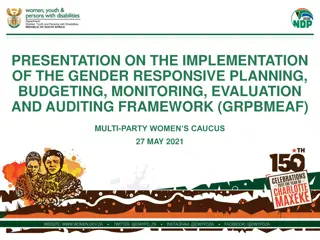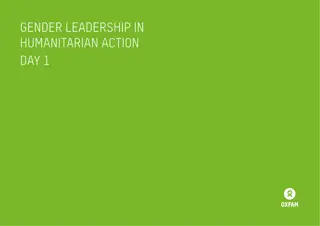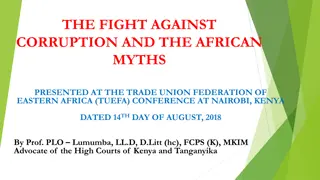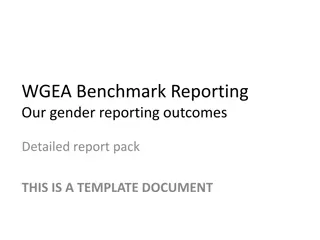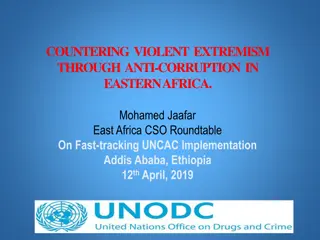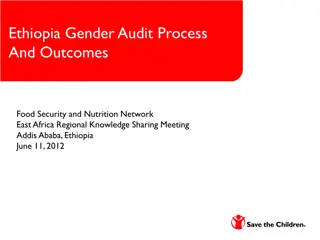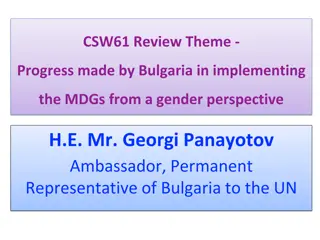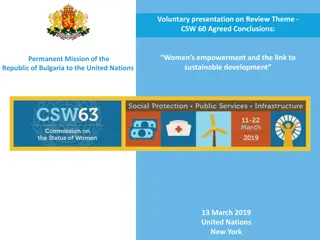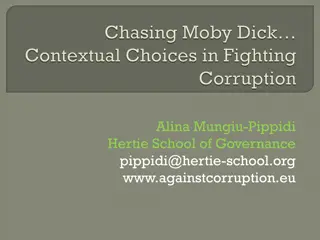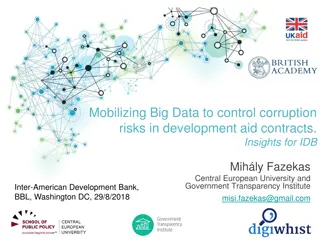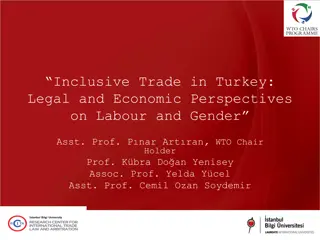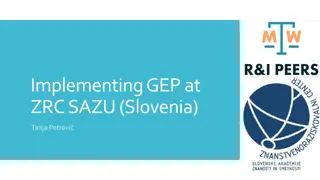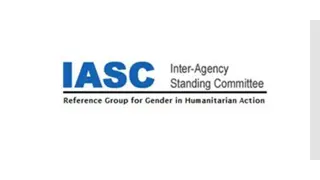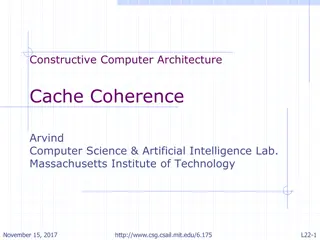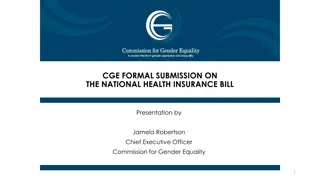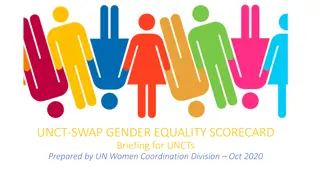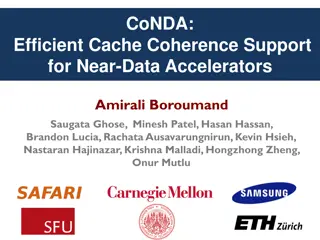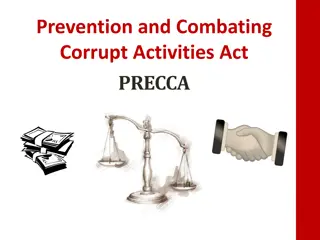Promoting Gender Equality and Fighting Corruption in Africa: AU Policy Coherence
Addressing the intertwining issues of corruption and gender inequality in Africa is crucial for sustainable development. This session will explore the complexities of corruption, engaging stakeholders, and the role of policy coherence in advancing women's empowerment. Key areas of focus include institutional mechanisms, human rights considerations, and the need for cohesive efforts across various platforms.
Download Presentation

Please find below an Image/Link to download the presentation.
The content on the website is provided AS IS for your information and personal use only. It may not be sold, licensed, or shared on other websites without obtaining consent from the author.If you encounter any issues during the download, it is possible that the publisher has removed the file from their server.
You are allowed to download the files provided on this website for personal or commercial use, subject to the condition that they are used lawfully. All files are the property of their respective owners.
The content on the website is provided AS IS for your information and personal use only. It may not be sold, licensed, or shared on other websites without obtaining consent from the author.
E N D
Presentation Transcript
1 Winning the fight against Corruption: A Sustainable Path to Gender Equality and Women s Empowerment in Africa SESSION 4: AU POLICY COHERENCE AND POLICY PLATFORMS
Statement of Problem 2 Magnitude of problem of corruption; Complex problem; Pervasive all sectors implicated; Multiplicity of actors (public, private, NGO, community, family etc; Historical, Political, Strategic, Development, Moral, Human Rights, Justice - imperative; Urgency to address problem of corruption on the continent; Collective problem institutions and individuals; Leadership challenge and opportunity to lead by example; Policy coherence BCP privilege and responsibility.
Issue for determination 3 Women, Gender and Development Directorate (WGDD); 3 (three) institutional mechanisms ( STC on Gender and Women Empowerment); AU Gender Pre-Summit; High Level panel on Gender Equality and Women s Empowerment (HLP on GEWE); Purposes of engaging and consulting relevant stakeholders on gender and empowerment issues; Joint aim to influence decisions of AU Policy Organs. Range of issues, options generated; Feed into the decision-making of AU Policy Organs (PRC, Ex. Council, Assembly).
Issue for determination contd. 4 ACHPR Rapporteur on women; gender, human rights, corruption. Concluding Observations; AfCHPR gender, corruption and justice; amicus curiae; AUABC corruption; mainstreaming gender with justice; ACERWC African child, gender; youth, corruption General Comments. PAP strengthening national parliaments to address gender and corruption Model laws. APRM governance index; data-gathering for fight against corruption.
Issue for determination contd. 5 Need for the creation of cohesion of various efforts Are there gaps/overlaps between the efforts of these platforms? How can these overlaps be synchronized? How can these gaps be filled? How can the various platforms work more efficiently and synergistically? 1. 2. 3. 4.
Session Objectives 6 1. Policy Coherence can be applied as tool to help the gender movement to pull its efforts together; 2. Work of AUC - institutional reform project; 3. Case Study on Policy Review of AUC / Organs; 4. Using policy coherence to coalesce efforts of gender platforms.
Background 7 Heads of State and Government Institutional Reform of the African Union (AU); Retreat of Heads of State and Government, Ministers of Foreign Affairs, Ministers of Finance Kigali, Rwanda 16 July 2016; Task of preparing study was assigned to H.E. Paul Kagame, Rwanda; Report gave rise to number of findings and recommendations; Built on an earlier study of Adedeji Report (2007); Outcomes of Mekelle Retreat (2016); Assembly/AU/Dec. 635 (XXVIII); Driving the institutional reforms at the Commission.
Justification for Institutional Reform at the AUC 8 Numerous normative commitments, weak implementation; Fragmentation of institutions, agencies and platforms; Multitude of focus areas; Overlapping mandates; Silo implementation of programmes; Weak management capacity; Unclear division of labour between organs, agencies, departments structures of the AU; Inefficient working methods; Weak co-ordination mechanism. Weak monitoring of results; Disjointed reporting of outcomes.
Re-configuration of the Bureau of the Chairperson 9 AUC Chairperson assumes office March, 2017; Re-arranging of portfolios within advisory team of the AUC Chairperson; Establishment of an Institutional Reform Unit in the office of the Chairperson reporting directly to the Chairperson Establishment of a new portfolio Policy Coherence; Technical portfolio support to the reform process; Identify the scope of the challenge, identify issues and propose options for reform; Time-line for implementation of different aspects of incoherence.
Concept of Policy Coherence 10 Policy Coherence: Both a goal and an approach; Goal meant to get policies to speak to each other; also, institutions to speak to each other; efforts to coalesce. Approach or a process it provides a logical method that can be used to review and analyze policies and institutions to identify areas of incoherence; Seeks to achieve synergies and complementarities; Aims to fill gaps between different policy areas and to string together efforts of different actors into one cohesive and comprehensive outcome.
11 Policy Coherence Review between the AUC and other AU Organs CASE STUDY 1 (JUNE 2017 MARCH 2018)
Scope of the Issue 12 Statutes of the African Union establish a multiplicity of organs: Policy Organs - Permanent Representative Committee (PRC), Executive Council and the Assembly of Heads of State and Government, Peace and Security Council (PSC); Executing Organ NEPAD (developmental agency of the Union; Legislative Organ PAP (Pan-African Parliament); Judicial Organ African Court on Human and Peoples Rights (AfCHPR); Quasi-Judicial Organs African Commission on Human and Peoples Rights (ACHPR); Advocacy Organ African Committee of Experts on the Rights and Welfare of the Child (ACERWC); Advisory Organ Economic, Social and Cultural Council (ECOSOCC); Monitoring Organ African Peer Review Mechanism (APRM); Knowledge Generating Organ AU Commission on International Law (AUCIL)
Statement of the Problem 13 Multiplicity of Organs; Similar Mandates; Opportunity for complementarity; Are the organs speaking to each other? Are the policies positions, outputs and outcomes speaking to each other? Are there platforms or mechanisms available for coalescence of efforts? Are these platforms being utilized? Is value being derived from these platforms? How are the results of collaboration, complementarity or synergy being reported?
Approach and Methodology 14 Step 1 : Literature review of indicators of institutional coherence; Step 2 : Develop a policy coherence framework: Step 3 : Desk-top review of the statutory mandates of each of the organs; Step 4 : Analysis of points of overlap in mandate; Step 5 : Developed a Mapping of overlapping mandates; Step 6 : Constitute a Technical Working Group comprising focal persons; Step 7 : Conduct one-on-one interviews with focal persons; Step 8 : Report on issues and options.
Policy Coherence Mapping Framework 15 Functional Areas AUC PAP ACHPR AfCHPR ACERWC AUABC APRM ECOSOC C Agenda-setting X Policy formulation X Programme formulation X X X X X X X X Programme Implementation X X X X X X Programme M & E X Programme Reporting X X X X X X X X Budget and financial reporting X Knowledge generation X X X X X Information dissemination X Partnership Development X X X
Output 16 Two key outputs: Issues Paper different mandates, interlinked, necessary; programme and budget planning disjointed; monitoring weak; reporting disjointed; co-ordination (AGA). 1. Options Paper (a) Strengthen AGA Platform; (b) Knowledge Management; (c) Joint Reporting. 2.
Personal Recommendations 17 Campaign against corruption that starts at the top leading by example; African Union Commission (AUC) at the helm of the continent; Network of Women in the AUC that are concerned about corruption; Put commitment where our mouth is, and initiate an institution-wide compact against corruption in the public sector beginning with ourselves; Sign anti-corruption pledges; Use digital platforms available to give momentum to the campaign and elevate it to crusade levels. Hashtag#It begins with me. Mentorship programme each woman in leadership position in the African Union will take an agreed number of women under their wing build leadership capacity to build stronger institutions.



